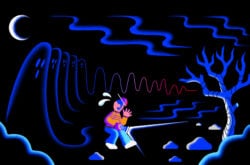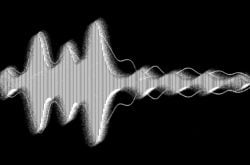Illustration: Ellie Suh
Temporal induction is an auditory illusion in which a tone seems to continue, even though it’s actually broken up.
In other words, a fainter sound can be interrupted by a louder sound, and still appear to be continuous. In this article, let’s demonstrate temporal induction using a sine wave and a white noise signal. Although this phenomenon might not have immediately obvious applications for music production, it’s worth noting that it has various other implications for the world of sound; for example, research on temporal induction suggests that birds can understand context!
Learning by doing
When I started writing this article, I admittedly didn’t have the most detailed idea of what temporal induction even was, so this was also a learning experience for me. I set out to learn about temporal induction using the most effective autodidactic technique I’ve employed over the years: trying it out myself.
But first, I reread the abstract of the paper I referenced earlier. Then, I reread it again, understanding a few more words this time. Eventually, I discerned that the researchers performed an experiment by replacing small segments of birdsong with silence, with white noise, and with another bird’s song.
Exploring temporal induction with Ableton Live
From there, I attempted to approximate this effect in Ableton Live. My hypothesis was that if I selected some audio samples and processed them in a similar way as the researchers did, I would be able to induce temporal induction in my own perception. First, I created four “base” audio samples: a sine wave of constant frequency and amplitude, a sine wave walking up a chromatic scale, a trance synth sample from Parallax, and a field recording of some birdsong as an homage to the paper that inspired this post.
Here’s the first experiment: a sine wave, set using Live’s faders at -10 dBFS, interrupted by bursts of white noise, first 200 ms and then 125 ms in length. The idea here was that if the interrupted sound is fainter than the interrupting sound, our brains would be more likely to fill in the missing signal.
Personally, I don’t experience the phenomenon of temporal induction when I listen to the above sample. I’m able to discern that the sine wave is interrupted, and the illusion of continuity doesn’t occur.
I figured maybe a tone that doesn’t change pitch is too static for our brains to “replace” the missing signal. So, the next experiment used the same sine wave, this time going up in pitch along the chromatic scale.
This seems to be getting a little closer! Remember, we’re looking for the illusion of an uninterrupted tone despite the noise cutting in. I’m still able to discern that there’s an interruption in the sine wave, but it doesn’t feel quite as obvious as the previous experiment.
Let’s try something else—for the next experiment, we’ll use a melodic sample as source material instead of a sine wave. My hypothesis is that if our brains can be familiar with the harmonic content of the sample, we’ll be more likely to “fill it in” subconsciously when the noise interrupts the signal. I started with this trance sample, adding in 100 ms bursts of white noise across random times in the arrangement.
Now we’re talking! When I (and hopefully you) listen back to this experiment, even though I obviously know that the sample is being interrupted by white noise, my brain “fills in the gaps” because of the harmonic context of the rest of the sample. I still hear the white noise, but it reminds me of, say, a snare sound or a cymbal sample being triggered, instead of a complete interruption in the sound like the last two experiments. This is the illusion of temporal induction coming into play!
Just for good measure, I thought it might be fun to try one more experiment. Since the original research paper used starling songs as a birdsong for their tests, I found this starling song on Splice Sounds, and then inserted white noise bursts lasting 200 ms at random intervals throughout.
I think this experiment was actually pretty successful as well! Although the effect isn’t quite as striking as it was for the previous experiment, I do seem to experience temporal induction when listening to this audio file—when the white noise hits, it seems to me that the rest of the recording continues anyway, even though I know it actually doesn’t. I suspect that the effect might not be as pronounced because my brain is more accustomed to listening to music samples than it is to birdsong. Perhaps the illusion would be more obvious for this sample to a starling than it was to me.
So what does temporal induction have to do with music production?
As I implied at the top of this article, I don’t think temporal induction is going to become a hot new production technique anytime soon. However, I’m really pleased with how these experiments turned out, and I think we still did learn something today. As producers, we don’t always need to fill up our arrangements to the brim—listeners’ brains are amazing things, and they will use context clues to fill in the sounds that they perceive to be missing. As a result of this experimentation, I’m challenging myself to ”let the context do the work” in my arrangements by removing notes or audio at choice moments. Even if we can’t completely reconstruct a full sample from context alone, “doing more with less” is a powerful production axiom, and the underlying concepts of the phenomenon of temporal induction may be one small reason why it works so well.
Explore royalty-free sounds from leading artists, producers, and sound designers:
February 11, 2022



